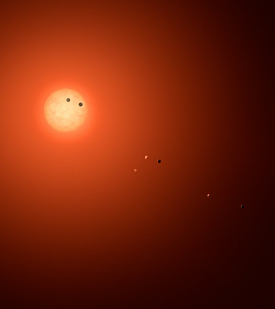Hubble delivers first insight into atmospheres of potentially habitable planets orbiting TRAPPIST-1 [heic1802]
5 February 2018
An international team of astronomers has used the NASA/ESA Hubble Space Telescope to look for atmospheres around four Earth-sized planets orbiting within or near TRAPPIST-1's habitable zone. The new results further support the terrestrial and potentially habitable nature of three of the studied planets. The results are published in Nature Astronomy. |
| Seven planets orbiting the ultracool dwarf star TRAPPIST-1. Credit: NASA |
Seven Earth-sized planets orbit the ultracool dwarf star TRAPPIST-1, 40 light-years away from the Earth [1]. This makes TRAPPIST-1 the planetary system with the largest number of Earth-sized planets discovered so far. These planets are also relatively temperate, making them a tantalizing place to search for signs of life beyond our Solar System. Now, an international team of astronomers has presented a study in which they used the NASA/ESA Hubble Space Telescope to screen four planets in the system – TRAPPIST-1d, e, f and g – to study their atmospheres [2].
Three of the planets orbit within the system's habitable zone, the region at a distance from the star where liquid water – the key to life as we know it – could exist on the surface of a planet. The fourth planet orbits in a borderline region at the inner edge of the habitable zone. The data obtained rule out a cloud-free hydrogen-rich atmosphere for three of the planets – but for the fourth planet, TRAPPIST-1g, such an atmosphere could not be excluded [3].
Lead author Julien de Wit, from the Massachusetts Institute of Technology, USA, describes the positive implications of these measurements: "The presence of puffy, hydrogen-dominated atmospheres would have indicated that these planets are more likely gaseous worlds like Neptune. The lack of hydrogen in their atmospheres further supports theories about the planets being terrestrial in nature. This discovery is an important step towards determining if the planets might harbour liquid water on their surfaces, which could enable them to support living organisms."
The observations were made while the planets were in transit in front of TRAPPIST-1. In this configuration a small section of the star's light passes through the atmosphere of the exoplanet and interacts with the atoms and molecules in it. This leaves a weak fingerprint of the atmosphere in the spectrum of the star.
While the results rule out one type of atmosphere, many alternative atmospheric scenarios are still consistent with the data gathered by de Wit and his team. The exoplanets may possess a range of atmospheres, just like the terrestrial planets in our Solar System [4].
"Our results demonstrate Hubble's ability to study the atmospheres of Earth-sized planets. But the telescope is really working at the limit of what it can do," adds co-author Hannah Wakeford from the Space Telescope Science Institute, illustrating both the power and limitation of Hubble.
These latest findings complement the analysis of ultraviolet observations made with Hubble in 2017 (heic1713) and help us understand more about whether life might be possible in the TRAPPIST-1 system.
By ruling out the presence of a large abundance of hydrogen in the planets' atmospheres, Hubble is helping to pave the way for the NASA/ESA/CSA James Webb Space Telescope.
"Spectroscopic observations of the TRAPPIST-1 planets with the next generation of telescopes – including the James Webb Space Telescope – will allow us to probe deeper into their atmospheres," concludes Michael Gillon, from the University of Líege, Belgium. "This will allow us to search for heavier gases such as carbon, methane, water, and oxygen, which could offer biosignatures for life."
Notes
[1] The planets were discovered using the ground-based TRAPPIST-South at ESO's La Silla Observatory in Chile; TRAPPIST-North in Morocco; the orbiting NASA Spitzer Space Telescope; ESO's HAWK-I instrument on the Very Large Telescope at the Paranal Observatory in Chile; the 3.8-metre UKIRT in Hawaii; the 2-metre Liverpool and 4-metre William Herschel telescopes on La Palma in the Canary Islands; and the 1-metre SAAO telescope in South Africa.
[2] The observations were performed in the infrared with the Wide Field Camera 3 (WFC3) between December 2016 and January 2017.
[3] An atmosphere largely dominated by hydrogen, if cloud-free, should yield prominent spectroscopic signatures in the near infrared. However, the spectra for TRAPPIST-1d, -e, and -f do not show significant features.
[4] This includes atmospheres dominated by water vapor, nitrogen, carbon dioxide or tenuous atmospheres composed of a variety of chemical species.
More information
The Hubble Space Telescope is a project of international cooperation between ESA and NASA.
The team is composed of Julien de Wit (Massachusetts Institute of Technology, USA), Hannah R. Wakeford (NASA Goddard Space Flight Center, USA), Nikole K. Lewis (Space Telescope Science Institute, USA), Laetitia Delrez (Cavendish Laboratory, University of Cambridge, UK), Michael Gillon (Université de Liège, Belgium), Brice-Olivier Demory (Cavendish Laboratory, University of Cambridge, UK; University of Bern, Switzerland), Emeline Bolmont (Astrophysics Division of CEA de Saclay, France), Vincent Bourrier (Observatoire de l'Université de Genève, Switzerland), Adam J. Burgasser (University of California San Diego, USA), Emmanuel Jehin (Université de Liège, Belgium), Jeremy Leconte (Université Bordeaux, France; CNRS, France), Susan M. Lederer (NASA Johnson Space Center, USA ), Frank Selsis (Université Bordeaux, France; CNRS, France), Vlada Stamenkovic (Jet Propulsion Laboratory, USA; California Institute of Technology, USA), and Amaury H. M. J. Triaud (University of Cambridge, UK)
Contacts
Julien de Wit
Massachusetts Institute of Technology
Cambridge, USA
Tel: +1 617 258 0209
Email: jdewit![]() mit.edu
mit.edu
Hannah Wakeford
Space Telescope Science Institute
Baltimore, USA
Email: Hannah.Wakeford![]() nasa.gov
nasa.gov
Michael Gillon
Université de Liège
Liège, Belgium
Tel: +32 4 3669743
Email: michael.gillon![]() ulg.ac.be
ulg.ac.be
Nicole Shearer
ESA/Hubble Public Information Officer
Garching bei München, Germany
Tel: +49 8932006376
Email: nshearer![]() eso.org
eso.org






